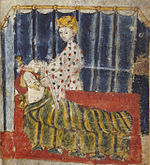MOVIE REVIEW: “The Green Knight”
“The Green Knight” takes us back in time

An illustration from the 1400s edition of “Sir Gawaine and the Green Knight”. The current film is based on the story found in the poem by Gawaine the Poet. Wikimedia.
“Why Greatness? Why Is Goodness Not Enough?” This is the question Gawain, played by Dev Patel, has to ask himself in “The Green Knight,” the new movie from writer and director David Lowery. It is based on the fourteenth-century medieval poem “Sir Gawain and the Green Knight” by the Gawain Poet.
At the beginning of the film, on Christmas morning, Gawain attends a feast at the Round Table, but he is not a knight yet, despite his uncle, King Arthur, expecting him to become “a great man.” The Green Knight arrives at this feast, and gives Gawain the chance he needs to become great: if one of the men can hit the Green Knight during a duel, they will be able to have his axe, but only if they promise to return in one year to receive the same blow. Gawain is the only one to agree to this.
In the fight, Gawain beheads the Green Knight, and the Knight simply picks up his head and goes back to his home, the Green Chapel, leaving Gawain with the axe. A year passes, and Gawain is faced with a choice: he can either follow the rules of the game and meet the Knight, where he will meet certain death, or refuse to take the six-day journey to the Green Chapel, which will prove him to be a coward.
“The Green Knight” tackles huge questions of life, religion, and honor, without ever leaving the story or its characters. Gawain can give up his life and become a hero, or live and stay a nobody. This question weighs heavy until the very end. David Lowery’s breakout film, “A Ghost Story,” felt too grandiose to be able to reach any form of intimacy with its portrayal of loss, but “The Green Knight is a medieval tale”— the story is big enough to carry big themes.
Visually, “The Green Knight” is gorgeous. The colors are vibrant and purposeful, and the cinematography is beautiful on the big screen. This medieval world of thieves, talking foxes, and ghosts is fully realized, and makes Gawain’s quest feel treacherous and mythical.
Despite being set in the Middle Ages, “The Green Knight” is a thoroughly modern film, which comes through in the crisp editing and dynamic score.
The movie is certainly inspired by past directors of medieval films, like Ingmar Bergman and Andrei Tarkovsky, but Lowery is confident in his own style, and “The Green Knight” feels like a fresh method of storytelling.
Dev Patel gives an excellent performance in this movie: he is given little dialogue, but his expressions make us care about him, and understand his decisions.
The supporting cast, which includes Barry Keoghan, Joel Edgerton, Katie Dickie, and Sean Harris, is consistent, too—they know where to find rhythm in the ornate dialogue so that it never comes off as hokey. These side characters only show up briefly on different stages of Gawain’s journey, but they give an added layer of life and color to the movie.
“The Green Knight” works mostly on an intellectual level, but the beautiful visuals and solid acting make it a good watch, as well as a technical achievement.

Quinn is a senior at East. He is passionate about movies and music, and enjoys writing and reading. He enjoys writing reviews, especially for independent...





